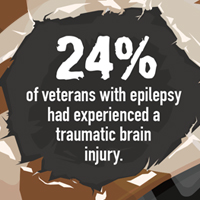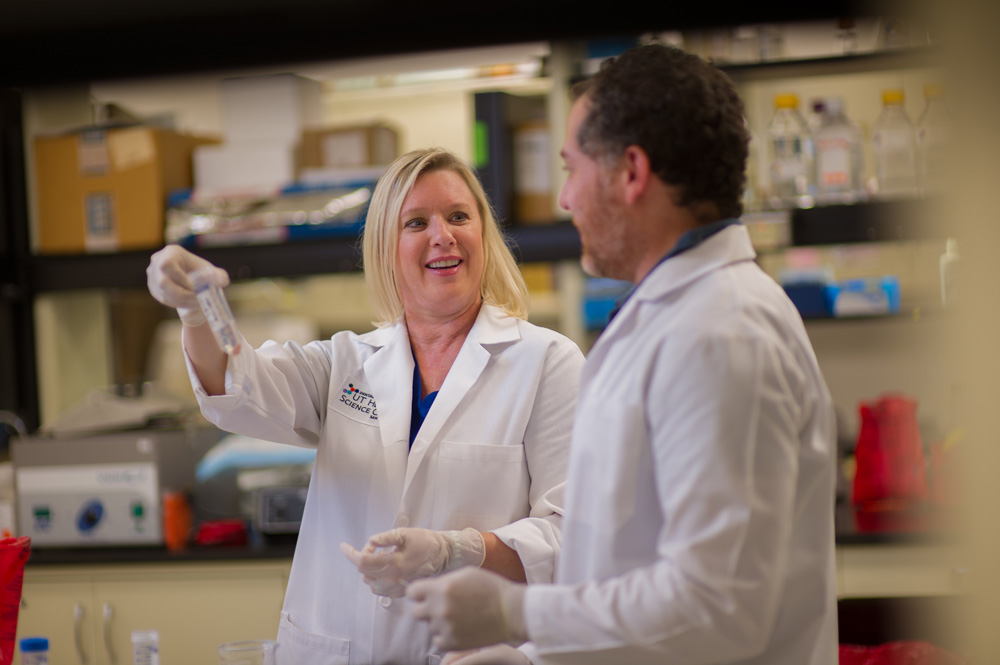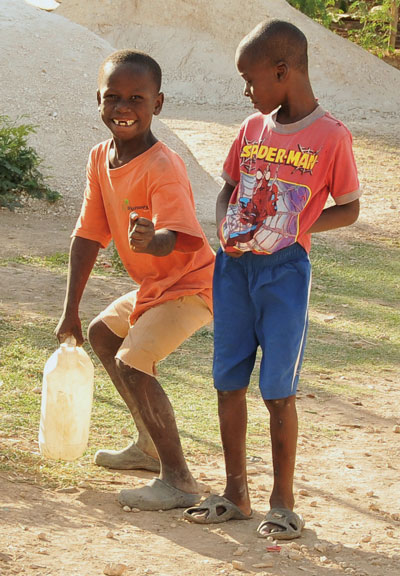Appointments and awards

Steven Bailey, M.D., was inducted into the inaugural 2014 Class of Master Fellows of the Society forCardiovascular Angiography and Interventions, the professional medical society for adult and pediatric invasive/interventional cardiologists. He is professor and chief of the Janey and Dolph Briscoe Division of Cardiology at the Health Science Center and is a cardiologist with UT Health San Antonio.

Peter J. Houghton, Ph.D., was named director of the Greehey Children’s Cancer Research Institute and holder of the Greehey Distinguished Chair for the Children’s Cancer Research Institute.

Cynthia Mojica, Ph.D., is one of five new appointees to the Advisory Committee on Minority Health, overseen by the Office of Minority Health at the U.S. Department of Health and Human Services. Dr. Mojica is a researcher at the Institute for Health Promotion Research.

Jacqueline Lee Mok, Ph.D., was named vice president for academic, faculty and student affairs. Most recently, she worked as vice president/chief of staff and secretary of the Board of Trustees at Johns Hopkins University, where she also was a presidential research fellow in 2013.
Young at heart
 Cardiovascular disease is the greatest killer of humans the world over, presenting huge financial and quality-of-life issues. It is well known that the heart becomes less efficient with age in all mammals studied to date, even in the absence of overt cardiac disease.
Cardiovascular disease is the greatest killer of humans the world over, presenting huge financial and quality-of-life issues. It is well known that the heart becomes less efficient with age in all mammals studied to date, even in the absence of overt cardiac disease.
But scientists still don’t have a good understanding of how to prevent these functional declines.
The longest-lived rodent, the naked mole rat, beats these odds and escapes cardiovascular aging, at least in ages equivalent to 92-year-old humans, researchers from the Long School of Medicine reported.
Kelly Grimes, a graduate student in the Health Science Center’s Barshop Institute for Longevity and Aging Studies, has conducted the first studies of naked mole rat cardiovascular function. Her findings of maintained cardiovascular function during aging support earlier studies that this species resists the common signs of aging.
She found that, at rest, the heart of the naked mole rat beats very slowly at 250 beats per minute. The rodent should have a heart rate twice as fast for its body size. The blood pressure in naked mole rats is also very low, as is the amount of blood the heart pumps and how hard it contracts to pump the blood.
"However, if they need to, for example during exercise, naked mole rats can ramp up their cardiac function with ease," Grimes said. "Their entire cardiovascular system seems to be optimized."
These data are from two papers recently published by Grimes and Rochelle Buffenstein, Ph.D., as part of a study supported by the American Heart Association. Dr. Buffenstein emphasized that the naked mole rat is unlike any other cardiovascular aging model studied.
"It looks like the naked mole rat maintains heart function at youthful levels at least till age 90," Dr. Buffenstein said. "Clearly these animals hold the secret to healthy hearts in aging humans."
Why do humans, rats, mice, monkeys, dogs and other animals show declines, but not the naked mole rat? Grimes is studying molecular mechanisms that might be protecting the naked mole rats’ cardiovascular structure and function. These protective mechanisms are likely closely linked to their natural subterranean environment and exceptional stress resistance.
The two papers are in the American Journal of Physiology-Heart and Circulatory Physiology published by the American Physiological Society.
Barshop Institute gets $7.5 million for aging intervention research
 Exploring agents to help us live longer and healthier has become a multimillion-dollar project for the Barshop Institute for Longevity and Aging Studies.
Exploring agents to help us live longer and healthier has become a multimillion-dollar project for the Barshop Institute for Longevity and Aging Studies.
Over the next five years, scientists will receive $7.5 million from the National Institute on Aging to test for compounds that enhance healthy aging in mice.
The Barshop Institute is part of the NIA Interventions Testing Program, which began in 2004, and works with the University of Michigan and the Jackson Laboratory to test aging interventions. The Barshop Institute tests the effects of drugs on longevity and houses the ITP Pharmacology Unit.
"This grant represents a doubling in funding over our previous ITP award," said Randy Strong, Ph.D., director and principal investigator of the San Antonio ITP. "This is now a $22 million consortium, with a third of the funding coming to the Barshop Institute in San Antonio."
The program has studied the effects of 25 compounds in 35 survival studies. So far, five interventions have shown promise, including rapamycin, a medication that extended the life span of mice, even those only treated late in life. The anti-diabetic drug acarbose is also showing potential, said Dr. Strong, professor of pharmacology in the Long School of Medicine and research career scientist at the South Texas Veterans Health Care System.
Early results have already impacted the fields of geriatrics and gerontology, providing the first strong evidence that a single drug can extend longevity by delaying or preventing the onset of multiple age-related diseases. Clinical trials are planned or are already under way to extend these findings to humans.
The NIA started a similar program using short-lived microscopic roundworms called Caenorhabditis elegans as an initial screen to speed up the identification of even more potential anti-aging interventions, Dr. Strong said.
"We are about the business of making lives better," said Health Science CenterPresident William L. Henrich, M.D., MACP. "Basic science is critically important, as is translating discoveries to patient care. Basic science is the first step on the continuum. Translating basic science discoveries to better techniques and practices is what brings it full circle. In the end, it’s all about the patient’s life."
Rapamycin testing in the ITP is having a direct economic impact on San Antonio. The ability of rapamycin-related drugs to potentially slow the aging process led to the establishment of a San Antonio biotech company, Rapamycin Holdings Inc., which is licensing exclusive rights to intellectual property central to several aspects of the rapamycin discovery.
Connecting the dots
 Veterans of the Afghanistan and Iraq wars who sustained mild traumatic brain injuries (TBIs) were 28 percent more likely to have epilepsy than those with without TBIs, Health Science Center researchers found.
Veterans of the Afghanistan and Iraq wars who sustained mild traumatic brain injuries (TBIs) were 28 percent more likely to have epilepsy than those with without TBIs, Health Science Center researchers found.
They studied the medical records of veterans from both wars who sustained traumatic brain injuries. Similar to prior studies, this research also showed that veterans who suffered penetrating or severe TBIs had the highest risk of developing epilepsy.
"We saw that 24 percent of the veterans who had epilepsy also had experienced a TBI. That is compared to 11 percent of people without epilepsy," said Mary Jo Pugh, Ph.D., RN, associate professor in the Department of Epidemiology and Biostatistics who is also a research health scientist with the South Texas Veterans Health Care System and a veteran of the U.S. Air Force.
Funded by the VA Health Services Research and Development Administration, the research was based on the records of 256,284 Afghanistan and Iraq veterans who received inpatient and outpatient care in the Veterans Health Administration (VHA) in fiscal years 2009 and 2010.
Of the more than 2 million returning veterans, 15 to 19 percent of them have suffered a TBI with either loss of consciousness or altered mental state.
"The high prevalence of TBIs has raised concerns for the long-term consequences of neurotrauma in this population. Based on data from previous wars, there is a particular concern for the risk of post-traumatic epilepsy," Dr. Pugh said, adding that studies of veterans from World War II and the Korean War showed a link between combat-related head injury and epilepsy.
"This study shows us that we need to be prepared as a health care system," she said. "Given the large number of individuals who have sustained deployment-related TBIs, a substantial increased burden of epilepsy in this population is possible. The long-term consequences on the patient and the health care system includes increased risk of medical and social complications, including accidents, social stigmatization, loss of employment, inability to drive and even death. These veterans should be followed closely, and systems of care, such as the VHA Epilepsy Centers of Excellence, should be prepared to provide epilepsy specialty care for these individuals."
Two for one: Drug kills cancer cells and blocks pain

An anti-pain agent has been found to also dramatically shrink human oral cancer tumors in mouse models. The agent, capsazepine, caused no damage to surrounding tissues, researchers from the School of Dentistry and School of Medicine found.
"That’s the beauty," said Cara B. Gonzales, D.D.S., Ph.D., assistant professor of comprehensive dentistry and an investigator with the Cancer Therapy & Research Center. "Capsazepine kills cancers selectively, leaving normal tissues unharmed, and also acts on neurons to block pain, a desirable combination in a potential medication."
Oral squamous cell carcinoma is the eighth most common cancer in the U.S. with 40,000 new cases and nearly 8,000 deaths reported annually. Typically, tumors develop on the side of the tongue, and 60 percent of patients have large tumors before seeking help. The five-year survival rate is 30 percent.
But if caught early, the disease is curable, said Randal A. Otto, M.D., FACS, professor and chairman of the Department of Otolaryngology-Head & Neck Surgery in the Long School of Medicine.
"Anything that selectively attacks the tumor while not injuring the normal tissues can only help the patient," he said.
Capsazepine was developed to block TRPV1, a calcium channel found in pain-sensing neurons. When TRPV1 is activated, a pain signal is sent to the brain. Capsazepine may reduce oral cancer pain because it blocks tumor-secreted factors from stimulating TRPV1 on these neurons. Dr. Gonzales found that capsazepine also has anti-cancer activity that may be linked with its ability to increase oxidative damage in tumors. Enhanced oxidative stress leads to auto-destruction of the tumor cells, the researchers theorize.
So far, only local administration of capsazepine, directly into the primary tumors, has been tested.
"We would like to be able to deliver this therapy systemically to target metastatic disease," Dr. Gonzales said. "Our laboratory is working with the Center for Innovation in Drug Discovery, a partnership between the Health Science Center and The University of Texas at San Antonio, to develop novel drugs that are similar to capsazepine, with improved efficacy for the purpose of systemic administration to treat tumors that are inaccessible to local injection or that have metastasized."
The Health Science Center has claimed intellectual property on results of the study, which is described in the journal Oral Oncology.
A good combination: Dual-drug combo can cure hepatitis C
More than 90 percent of hepatitis C patients were cured in three months using a combination of pills already approved by the FDA.
When taken together, the drugs sofosbuvir and simeprevir resulted in nine out of 10 patients being cured. They were also well tolerated by patients, according to a study published in The Lancet.
Eric Lawitz, M.D., clinical professor in the Long School of Medicine and vice president of research and scientific development at the Texas Liver Institute, led the clinical trial conducted in the United States and funded by Janssen Pharmaceutical Companies.
Encouraging people to take a blood test to diagnose hepatitis C could result in their being treated with an oral regimen that could prevent serious liver diseases such as cancer, cirrhosis or liver failure. Hepatitis C is the leading cause of liver transplants in the U.S.
An estimated 3.2 million people nationwide have hepatitis C, and most do not know they are infected. Cure rates for hepatitis C patients with cirrhosis are historically lower than 50 percent, and the treatment has had numerous adverse effects. The previous standard of care with the drug interferon involved a complicated regimen of shots and up to 18 tablets a day for up to 48 weeks, and six months of follow-up care to determine if the therapy was successful. Side effects included rash, anemia and depression.
"We are now in the midst of a paradigm shift of moving away from complicated injection regimens," Dr. Lawitz said. "This trial provides a glimpse into the outcomes of sofosbuvir and simeprevir for treatment of hepatitis C. Both drugs are approved by the FDA but are not yet approved together for this treatment."
All-oral regimens hold promise for a hepatitis C cure rate of more than 90 percent of patients, including those with liver scarring, or cirrhosis. Study participants had the most common form of hepatitis C, called genotype 1, and were difficult to treat due to either failing a previous course of interferon and ribavirin, or having cirrhosis.
More than 150 million people worldwide have chronic hepatitis C, a major cause of liver cirrhosis and liver cancer. Annually 350,000 to 500,000 deaths are reported.
According to the U.S. Centers for Disease Control and Prevention, 75 percent of U.S. residents with chronic hepatitis C were born from 1945 through 1965. For this reason, the CDC recommends that people born during these years have a one-time test for hepatitis C to prevent the risk of more serious health problems.
Fat be gone
 What if you could flip a switch and start burning your excess fat? That could lead to more energy, and a lower risk of obesity and diseases such as type 2 diabetes. It sounds like a miracle switch, but researchers from the Long School of Medicine believe they have found it in the protein Grb10.
What if you could flip a switch and start burning your excess fat? That could lead to more energy, and a lower risk of obesity and diseases such as type 2 diabetes. It sounds like a miracle switch, but researchers from the Long School of Medicine believe they have found it in the protein Grb10.
The body is made up of white and brown adipose tissue, also called fat tissue. White tissue stores fat, while brown tissue releases it through energy. Both are important for regulating metabolism, but having too much white adipose tissue could lead to weight and health problems.
"We know that if we want to keep our body lean, we have to get rid of extra nutrients in the body, which means burning more energy," said Feng Liu, Ph.D., professor of pharmacology at the Health Science Center and director of the Metabolic Syndrome Research Center at Second Xiangya Hospital, Central South University in Changsha, China.
Converting the white tissue to brown, or "beigeing" the fat, could lead to this increase in energy. The researchers discovered the molecular pathway called mTORC1 that controls this beigeing, and Grb10 acts as the on-off switch. This protein is stimulated by cold stress, which causes the body to burn energy.
"Understanding how beigeing is controlled is so very important because, if we can improve energy expenditure, we can reduce obesity," Dr. Liu said.
The discovery has other implications, too. The mTORC1 pathway is also involved in aging, cardiovascular disease and cancer.
It's in your gut
 A high-fat diet may cause changes in people’s gut bacteria, leading to an increase in bacterial byproducts called endotoxins in the bloodstream. In older people and those with type 2 diabetes, the level of endotoxin is higher.
A high-fat diet may cause changes in people’s gut bacteria, leading to an increase in bacterial byproducts called endotoxins in the bloodstream. In older people and those with type 2 diabetes, the level of endotoxin is higher.
Nicolas Musi, M.D., director of the Barshop Institute for Longevity and Aging Studies at the Health Science Center, recently received $600,000 from the American Diabetes Association to lead a clinical research study into the issue.
"We all have a little bit of endotoxin in our body coming from the bacteria that live in our gut," Dr. Musi said. "But usually endotoxin does not come through the intestinal barrier into the blood, or very little does. We question whether the higher level of endotoxin in the blood of diabetics is caused by a high-fat diet that makes the intestinal barrier leaky, allowing endotoxin to spill into the blood."
The study will also explore how the level of endotoxin might affect insulin sensitivity and the body’s ability to metabolize sugar.
It’s official. CTRC retains national elite Cancer Center designation
 In September, the National Cancer Institute renewed the Cancer Therapy & Research Center’s official Cancer Center designation. An NCI Cancer Center designation is given to elite cancer centers, of which there are only four in Texas.
In September, the National Cancer Institute renewed the Cancer Therapy & Research Center’s official Cancer Center designation. An NCI Cancer Center designation is given to elite cancer centers, of which there are only four in Texas.
To qualify for the national designation, CTRC faculty and staff had to meet and exceed strict guidelines, such as continuing to make groundbreaking scientific discoveries, conducting innovative clinical trials, training the next generation of cancer doctors and reducing the burden of cancer for the people of San Antonio and South Texas.
"We are elated with these achievements—mainly because they help our patients," said CTRC Director Ian M. Thompson Jr., M.D. "Every conversation I have with a patient who is fighting cancer, or with a family member who is soaking up every word and asking questions so that person can fight alongside the loved one, is profoundly humbling. They are the real fighters, and we are so proud to serve them."
The CTRC serves a fast-growing area with a population of more than 4.4 million people in the region of Central and South Texas that includes Austin, San Antonio, Laredo and the Rio Grande Valley. With many Spanish speakers in its service area and higher rates of liver and cervical cancer along its borders, the CTRC has focused its mission on bilingual prevention education and outreach, collaboration with border physicians and cutting-edge clinical trials for cancer.
‘Zafè Kabrit se Zafè Mouton’
It was at once very familiar and all its own: a stage, caps and gowns, smiling graduates and a cheering crowd. But the setting was an off-duty nightclub just outside the Haitian capital of Port-au-Prince. Caps and gowns were often homemade and sometimes held together by duct tape. Graduates ranged from the very young to the very old.
The specific achievement being celebrated was entirely new to this part of the world and, yet, critically important: Each of the 430 graduates receiving a certificate this February day had completed a six-month curriculum through one of 17 Community Health Clubs across their city.
Developed in sub-Saharan Africa, Community Health Clubs are now bringing Caribbean communities together to prevent the spread of disease. There, they are facilitated by local community organizers in partnership with the Center for Medical Humanities & Ethics, part of the Long School of Medicine at the UT Health Science Center.
Three from the Center for Medical Humanities & Ethics traveled to Haiti for the graduation: director Ruth Berggren, M.D., FACP; Jason Rosenfeld, M.P.H., assistant director of global health; and academic and global health program coordinatorStephanie Gutierrez.
The mood was ecstatic. People traveled from muddy slums all over Port-au-Prince carefully groomed and meticulously attired, including one club of young girls in pristine white dresses, ruffled socks and patent-leather shoes. The fervent crowd broke out in call-and-response chants. Each club performed health-themed Creole skits or songs for a crowd of roughly 2,000. A candlelight ceremony was held to remind graduates not to let the light of their newfound knowledge go out.


These clubs are turning a traditional Haitian proverb on its head: "Zafè Kabrit pa Zafè Mouton" translates to "The goat’s business is not the sheep’s business." In Haiti, where a cholera outbreak has killed thousands and underscored deficiencies in water and sanitation systems, that mindset of minding your own business can be deadly. Accordingly, the health clubs have adopted a variation as their unifying slogan: "Zafè Kabrit se Zafè Mouton," or "The business of the goat IS the business of the sheep."
"Community matters everywhere, but in Haiti it’s essential," said Dr. Berggren, an infectious disease specialist. "How your neighbors deal with standing puddles of water and piles of trash, even how and where they relieve themselves, can determine whether your child gets sick. Community Health Clubs show neighbors how to look out for each other, and demonstrate the virtuous cycle that can follow."
Dr. Berggren and Rosenfeld bring together a unique combination of skills and experiences. Rosenfeld is a behavioral scientist with six years of experience in Africa, three of those in South Africa and Zimbabwe with Africa AHEAD, the organization that pioneered the approach.
The daughter of two public health physicians and an infectious disease specialist, Dr. Berggren grew up in Haiti from ages 4 to 14. She brings deep understanding of Haiti’s health challenges and culture, as well as language fluency and programmatic expertise.
In Haiti, a typical meeting begins with the club chanting its slogan: "health is wealth." There are always crowd-warming "animations": lighthearted dances, funny skits and songs. A facilitator asks whether homework is complete—perhaps changing a household practice. Then they launch into the new session, distributing picture cards and tackling a theme: sanitation, drinking water, hand washing and more.
It’s difficult to isolate the health impact of the clubs from other forces at work in a community. But Rosenfeld and Dr. Berggren are encouraged by knowledge increases and behavior changes they see, and are working on ways to better quantify the impact.

They are also working to extend their reach. Because students can’t visit Haiti due to a State Department travel warning, Rosenfeld traveled with medical students to the Dominican Republic to introduce the Community Health Club concept and conduct needs assessments. They went house to house, speaking to residents and making observations: Did the house have a latrine? How were food and water stored?
One student, Matt Mullane, described it as a defining experience that will strongly influence his career: "One of the big drives right now is for medicine to reconnect with communities. To do that, we need to understand how to approach communities and to see how community life influences health."
From there, local partners were identified: Jude François and Marie Ruthza Flavienne Vincent in Haiti, and the nonprofit Children of the Nations in the Dominican Republic.
Rosenfeld took the African curriculum—picture-based, so it can be used when illiteracy is widespread—and, with Dr. Berggren and local artists, adapted it to its new context.
Next up: Medical student Samy Bendjemil’s plan to take the clubs to Burkina Faso, Africa, earned a prestigious Fulbright U.S. Student Award. He laid groundwork during a previous global health trip with guidance from Dr. Berggren and Rosenfeld.
And there are plans to adapt the clubs to San Antonio, where they could be used to promote healthy lifestyles or address chronic problems like diabetes and obesity.
"I think the potential is great," Rosenfeld said. "I have enough confidence in the model that, once we find the right people to implement it, I believe it will take off."
See more photos of the Community Health Club graduation in Haiti.
[pexyoutube pex_attr_src="https://www.youtube.com/watch?v=PhbqPmXCdj4&feature=youtu.be"][/pexyoutube]



